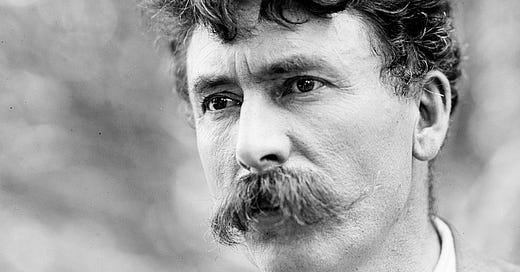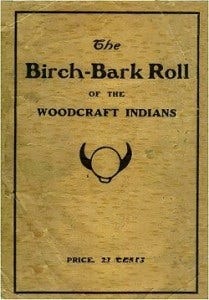Out with Robert Baden-Powell and in with Ernest Thompson Seton?
Why the 21st century Scouting Movement needs to embrace a new founder focused on the outdoors and conservation.
Ernest Thompson Seton and Robert Baden-Powell were among the leading men in the history of the Scouting movement, both contributing significantly to its formation and philosophy. Nonetheless, it is Baden-Powell who is often heralded as the founder of Scouting. The history of events muddies the waters, so to speak, as it often does, that it was Seton’s ideas who influenced Baden-Powell’s program.
But who are these men? And how did they influence each other and Scouting?
Ernest Thompson Seton was a naturalist, author, and artist. Seton’s "Birch Bark Roll," published in 1903, is a work that contains a wealth of knowledge about outdoor skills, wildlife, and the importance of nature in the lives of young people. Seton's commitment to teaching youth about the natural world was rooted in his belief outdoor experiences helped character development, leadership, and a sense of responsibility toward the environment. His emphasis on the importance of nature and hands-on learning laid the foundation for many of the principles that would later be incorporated into the Scouting movement.
Robert Baden-Powell, a British Army officer, encountered Seton’s work during his own explorations into youth organization and outdoor education. In 1907, he led a camp on Brownsea Island, which would eventually lead to the establishment of Scouts in 1908. Baden-Powell’s exposure to "Birch Bark Roll" provided him with the methods and philosophies that could be employed to engage young people in outdoor activities. It was Seton’s emphasis on storytelling, nature study, and practical skills that resonated with Baden-Powell program, though BP recognized the potential for these elements to be integrated into a cohesive program for youth.
Seton’s influence on Baden-Powell can be seen in the structure and content of the early Boy Scout movement. The "Birch Bark Roll" included a variety of outdoor skills, games, and training methods that Baden-Powell would adopt and adapt for his own programs. For instance, Seton’s emphasis on animal tracking and woodcraft became integral components of the Scouting curriculum—which can be found in BP’s Scouting for Boys.
Seton’s writings advocated for a sense of duty to others and the importance of community involvement, principles that became foundational tenets of Scouting. As Baden-Powell crafted the Boy Scout Promise and Law, the influence of Seton’s ideas about service and responsibility is evident. Seton writes, “Every man should be a good citizen, and a good citizen is one who is willing to serve his community and help his fellow men.”1
However, the relationship between Seton and Baden-Powell was not without its difficulties. While Baden-Powell did rely heavily from Seton’s work regarding its scoutcraft and woodcraft skills, the two men had different visions for the future of Scouting. Seton’s approach focused on nature and wildlife, while Baden-Powell emphasized military-style training and discipline—this difference led to tensions between the two leaders.
In 1910, Seton became the first Chief Scout of the Boy Scouts of America. However, as Baden-Powell’s vision for Scouting evolved, Seton found himself increasingly at odds with the direction the organization was taking. In 1915, he resigned from his position due to disagreements over the militaristic culture taking root in Scouting, which he believed detracted from its original purpose of fostering a love for nature and the outdoors. Despite this conflict, Seton’s early influence on Baden-Powell and the foundational principles of Scouting still remain. Seton explains his departure, “ I could not, in good conscience, continue to be a part of a movement that was become increasingly militaristic and which I felt was straying from its original purpose of fostering a love for nature and outdoor life.”2
Ernest Thompson Seton’s vision of Scouting emphasizes nature, conservation, and personal development, making it increasingly relevant for the 21st century as the movement has sought to shed its militaristic culture. Seton understood the profound connection between young people and the natural world, advocating for an approach that promotes good stewardship our common home—earth; and a love for the outdoors. Seton’s philosophy encourages youth to engage with nature, fostering a sense of responsibility towards the environment that aligns with contemporary concerns about ecological sustainability—see, The Environmental Science merit badge among others.
Seton’s emphasis on conservation and wildlife education provides a framework for Scouting that prioritizes ecological awareness. By focusing on skills such as tracking, camping, and understanding ecosystems, Seton’s model cultivates not only outdoor proficiency but also an enduring respect for nature. By integrating conservation initiatives into Scouting programs, such as tree planting or habitat restoration projects, the organization can inspire young people to take active roles in conservation.
Ultimately, Seton’s view of Scouting serves as a guiding principle for adapting the movement to contemporary values. By embracing his legacy, Scouting can evolve into a more inclusive, environmentally conscious organization that encourages youth to become not only skilled outdoor enthusiasts but also passionate advocates for conservation and sustainability in an ever-changing world.
Ernest Thompson Seton, The Birch Bark Roll of Woodcraft Indians (New York: Charles Scribner’s Sons, 1903).
Ernest Thompson Seton, The Story of My Life ((New York: Charles Scribner’s Sons, 1940.)





